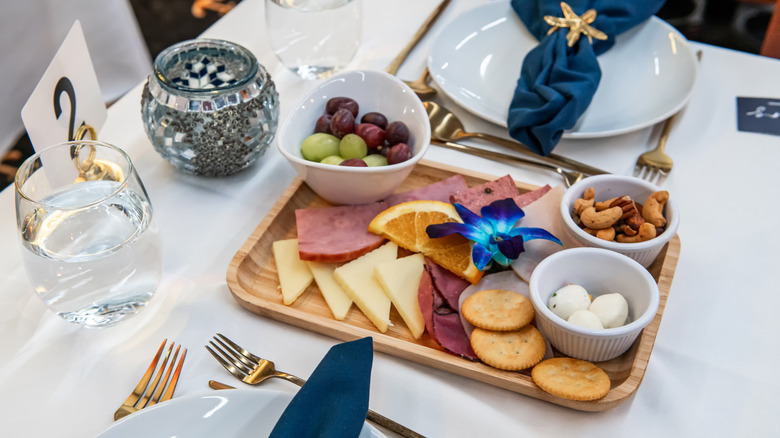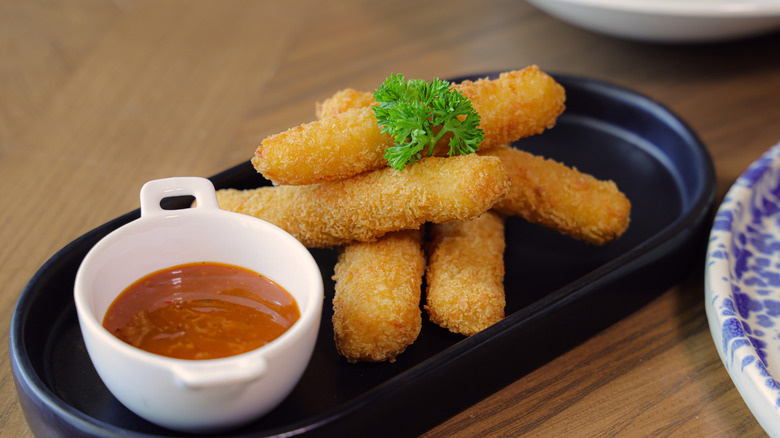Hors D'oeuvres Vs Appetizers: What's The Difference?
Jealousy and envy, disinterested and uninterested, and hors d'oeuvres and appetizers are often used interchangeably, but carry different meanings. While some linguistic delineations are clearcut, the difference between appetizers and hors d'oeuvres is a bit murky. Whether you're chomping on appetizers or hors d'oeuvres boils down to when, where, and why a food is served.
A rough answer for the difference between appetizers and hors d'oeuvres is that the former comes before a main course, while the latter is typically served outside of mealtime altogether. There is no clear-cut distinction, and you're sure to find exceptions to this rather broad definition, but this a generally correct way of looking at it. That Triple Dipper counts as a Chili's appetizer, not an hors d'oeuvre. But if you're trying to define the crab puffs served at your company Christmas party, you're probably looking at hors d'oeuvres.
What are hors d'oeuvres?
To discover the meaning of hors d'oeuvres, we can look at etymology. French in origin, the term hors d'oeuvres translates to "outside the work." Stemming from 16th century architectural practices, hors d'oeuvres originally signified structures unattached to a residence's main building while remaining part of the greater property, like pool houses. Eventually, hors d'oeuvres came to mean food served outside the main meal. While the precise reasons for the term's evolution are unknown, French chefs may have begun using it as such after encountering buffet-style dining while working in Russian kitchens.
Given the name's origins, it makes sense that hors d'oeuvres were fairly popular in France. Although the country did not invent hors d'oeuvres, they were very common in French dining throughout the 1600s and 1800s. Hors d'oeuvres gained traction in the United States during the era of happy hours and cocktail parties in the '40s and '50s.
Presentation has always mattered when it comes to hors d'oeuvres, given they're a party food often served at more upscale events. To aid with the ambiance, such small bites are often arranged on a plate in an attractive fashion, frequently garnished with herbs for aesthetic purposes. But the definition of hors d'oeuvre and appetizer blurred a bit in the United States during the 20th century, with menus often labeling small bites served at sit-down meals as "hors d'oeuvres" when the term "appetizer" might better apply. However, the word maintained its reputation for stateliness, the label "hors d'oeuvres" more likely to grace menus at pricier big city restaurants.
What are appetizers?
Appetizer, on the other hand, has Latin roots, meaning "to strive or long for." Appetizers became the first thing to order off menus during a period where Americans were prone to digestive problems. They were meant to whet the palate, or — as the word implies — to help those with subpar stomachs long for their food.
Appetizers also tend to be larger than hors d'oeuvres, which are often bite-sized. Hors d'oeuvres are also usually a medley of options, while appetizers are more typically a single dish. All that being said, these definitions are not set in stone. At this point, you might be saying, "Hey, wait just a minute..." while drumming up about 12 exceptions to these rules.
There's definitely such a thing as bite-sized appetizers, and these plates can certainly offer various options. (Remember our earlier Triple Dipper shout out?) And hors d'oeuvres, in turn, can precede a meal. Cocktail parties featuring hors d'oeuvres at weddings typically come before dinner. Even our own list of fancy appetizers you need to try before you die includes many items that could be considered hors d'oeuvres. Language is fluid, and strict delineations sometimes mean less over time. While there are subtle differences between hors d'oeuvres and appetizers, there's a decent amount of overlap as well. Just be cautioned that, if you use the terms interchangeably, pedantic foodies may correct you.


